Related Research Articles

The drum is a member of the percussion group of musical instruments. In the Hornbostel-Sachs classification system, it is a membranophone. Drums consist of at least one membrane, called a drumhead or drum skin, that is stretched over a shell and struck, either directly with the player's hands, or with a percussion mallet, to produce sound. There is usually a resonant head on the underside of the drum. Other techniques have been used to cause drums to make sound, such as the thumb roll. Drums are the world's oldest and most ubiquitous musical instruments, and the basic design has remained virtually unchanged for thousands of years.

The tambourine is a musical instrument in the percussion family consisting of a frame, often of wood or plastic, with pairs of small metal jingles, called "zills". Classically the term tambourine denotes an instrument with a drumhead, though some variants may not have a head. Tambourines are often used with regular percussion sets. They can be mounted, for example on a stand as part of a drum kit, or they can be held in the hand and played by tapping or hitting the instrument.
A membranophone is any musical instrument which produces sound primarily by way of a vibrating stretched membrane. It is one of the four main divisions of instruments in the original Hornbostel-Sachs scheme of musical instrument classification.

Peter Edward "Ginger" Baker was an English drummer. His work in the 1960s and 1970s earned him the reputation of "rock's first superstar drummer", for a style that melded jazz and African rhythms and pioneered both jazz fusion and world music.
Given the vastness of the African continent, its music is diverse, with regions and nations having many distinct musical traditions. African music includes the genres amapiano, Jùjú, Fuji, Afrobeat, Highlife, Makossa, Kizomba, and others. The music and dance of the African diaspora, formed to varying degrees on African musical traditions, include American music like Dixieland jazz, blues, jazz, and many Caribbean genres, such as calypso and soca. Latin American music genres such as cumbia, conga, rumba, son cubano, salsa music, bomba, samba and zouk were founded on the music of enslaved Africans, and have in turn influenced African popular music.

The steelpan is a musical instrument originating in Trinidad and Tobago. Steelpan musicians are called pannists.
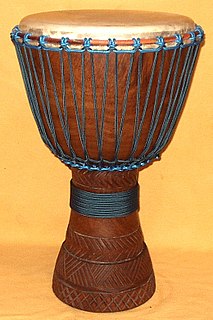
A djembe or jembe is a rope-tuned skin-covered goblet drum played with bare hands, originally from West Africa. According to the Bambara people in Mali, the name of the djembe comes from the saying "Anke djé, anke bé" which translates to "everyone gather together in peace" and defines the drum's purpose. In the Bambara language, "djé" is the verb for "gather" and "bé" translates as "peace."

The goblet drum, is a single head membranophone with a goblet shaped body. It is most commonly used in the traditional music of Egypt, where it is considered the National symbol of Egyptian Shaabi Music. The instrument is also featured in traditional music from West Asia, North Africa, South Asia, and Eastern Europe. The African djembe is also a goblet membranophone. This article focuses on the Eastern and North-African goblet drum.
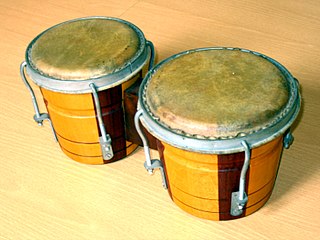
Bongos are an Afro-Cuban percussion instrument consisting of a pair of small open bottomed hand drums of different sizes. They are struck with both hands, most commonly in an eight-stroke pattern called martillo (hammer). They are mainly employed in the rhythm section of son cubano and salsa ensembles, often alongside other drums such as the larger congas and the stick-struck timbales.
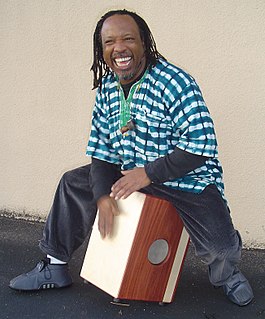
A cajón is a box-shaped percussion instrument originally from Peru, played by slapping the front or rear faces with the hands, fingers, or sometimes implements such as brushes, mallets, or sticks. Cajones are primarily played in Afro-Peruvian music, but has made its way into flamenco as well. The term cajón is also applied to other box drums used in Latin American music, such as the Cuban cajón de rumba and the Mexican cajón de tapeo.
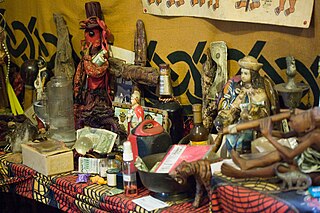
African diaspora religions are a number of related Pagan beliefs that developed in the Americas in various nations of the Caribbean, Latin America and the Southern United States. They derive from Pagan traditional African religions with some influence from other religious traditions, notably Christianity and Islam.

Developed and used by cultures living in forested areas, drums served as an early form of long-distance communication, and were used during ceremonial and religious functions.

A slit drum or slit gong is a hollow percussion instrument. In spite of the name, it is not a true drum but an idiophone, usually carved or constructed from bamboo or wood into a box with one or more slits in the top. Most slit drums have one slit, though two and three slits occur. If the resultant tongues are different width or thicknesses, the drum will produce two different pitches. It is used throughout Africa, Southeast Asia, and Oceania. In Africa such drums, strategically situated for optimal acoustic transmission, have been used for long-distance communication.

The music of West Africa has a significant history, and its varied sounds reflect the wide range of influences from the area's regions and historical periods.

The talking drum is an hourglass-shaped drum from West Africa, whose pitch can be regulated to mimic the tone and prosody of human speech. It has two drumheads connected by leather tension cords, which allow the player to change the pitch of the drum by squeezing the cords between their arm and body.
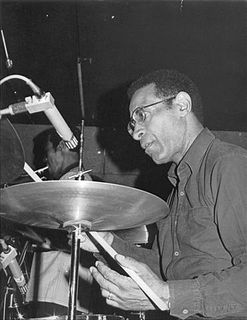
Jazz drumming is the art of playing percussion in jazz styles ranging from 1910s-style Dixieland jazz to 1970s-era jazz fusion and 1980s-era Latin jazz. The techniques and instrumentation of this type of performance have evolved over several periods, influenced by jazz at large and the individual drummers within it. Stylistically, this aspect of performance was shaped by its starting place, New Orleans, as well as numerous other regions of the world, including other parts of the United States, the Caribbean, and Africa.

The African Beat is a jazz album released by Art Blakey and The Afro-Drum Ensemble in November 1962 on Blue Note Records. He described it as the first opportunity he had to work with drummers from Africa; as a blend of American jazz with the traditional rhythms and tonal colors in the percussion of that continent. The album features compositions by African and American musicians, all based on aspects of West African music.

The Yoruba people are a West African ethnic group that mainly inhabit parts of Nigeria, Benin and Togo. The areas of these countries primarily inhabited by Yoruba are often collectively referred to as Yorubaland. The Yoruba constitute more than 50 million people in Africa, are a few hundred thousand outside the continent, and bear further representation among members of the African diaspora. The vast majority of the Yoruba population is today within the country of Nigeria, where they make up 21% of the country's population according to CIA estimations, making them one of the largest ethnic groups in Africa. Most Yoruba people speak the Yoruba language, which is the Niger-Congo language with the largest number of native or L1 speakers.

The Akan Drum is a drum that was made in West Africa and was later found in the Colony of Virginia in North America. It is now the oldest African-American object in the British Museum and possibly the oldest surviving anywhere. The drum is a reminder of all three continents' involvement in the estimated twelve million people transported across the Atlantic Ocean as part of the transatlantic slave trade. The drum is normally displayed in Room 26, the North American gallery, in the British Museum.
Amapiano is a style of house music that emerged in South Africa in 2012. It is a hybrid of deep house, jazz and lounge music characterized by synths and wide percussive basslines.
References
- ↑ Trends in Twenty-First Century African Theatre and Performance, edited by Kene Igweonu, p. 389